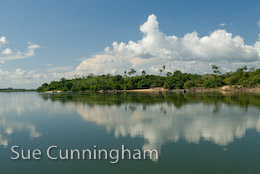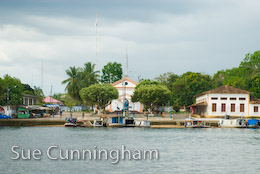Click here: www.ipcst.org/LastLeg to go to a slideshow of images relevant to this post. To return, simply close the slideshow window. The slideshow may take some time to load, especially if you have a slow internet connection.
 Altamira is one of the ten members of the Belo Monte Consortium, a group of municipalities supporting the construction of a huge hydroelectric dam close to Altamira by the national electricity generating company Eletronorte. At first glance, the dam seems to be a well-founded project which will bring benefits to the region, and to Brazil as a whole, while causing disruption only to a small number of people.
Altamira is one of the ten members of the Belo Monte Consortium, a group of municipalities supporting the construction of a huge hydroelectric dam close to Altamira by the national electricity generating company Eletronorte. At first glance, the dam seems to be a well-founded project which will bring benefits to the region, and to Brazil as a whole, while causing disruption only to a small number of people.
The project is part of the Brazilian government’s “Programa de Aceleração do Crescimento” (Accelerated Growth Programme), but has already run into a quagmire of legal challenges which threaten to derail the government’s stated target of completing the licensing procedure by the middle of 2008.
Core to the legal challenges is the mechanism for consulting the Indian communities which would be affected. According to a ruling of the Regional Federal Court (Tribunal Regional Federal), this is the direct responsibility of Congress, and cannot be carried out by IBAMA, the government environment agency which has already begun the process of defining the terms of the consultation, without an act of congress.
During the last part of the Heart of Brazil Expedition, all of the Indian villages and riverside communities (ribeirinhos) we visited, from before São Félix do Xingu to beyond Altamira, voiced strong opposition to the dam. They told us that they are planning a large protest meeting.
There are many questions hanging over the dam. Who exactly will benefit from the huge generating capacity which is proposed? There is no shortage of electricity in the region, and recent progress in solar panel technology promises to provide even rural properties with abundant power.
 The nearby Tucurui dam generates abundant power during most of the year, and its capacity has recently been practically doubled by the completion of a second phase. But the main beneficiaries of Tucurui have been the private mining and metal corporations, which have negotiated very beneficial contracts which amount to the supply of subsidised electricity for their commercial activities.
The nearby Tucurui dam generates abundant power during most of the year, and its capacity has recently been practically doubled by the completion of a second phase. But the main beneficiaries of Tucurui have been the private mining and metal corporations, which have negotiated very beneficial contracts which amount to the supply of subsidised electricity for their commercial activities.
The Tucurui site was recently occupied by people who were displaced by the construction of the dam over twenty years ago, who are still today fighting for adequate compensation.
Since the Xingu dries up substantially during the months from July to October each year, many question the technical viability of the project. A recently published book, titled Tenotã–mõ (which in the Arawete language means “What Has Started” (o que segue à frente, o que começa) explains that a second dam will be required to justify the existence of the first by keeping it supplied with water during the dry months, thereby allowing it to operate throughout the year. Eletronorte have not been straightforward in disclosing this. The second dam would flood fifteen times more land than the first, and affect many more of the indigenous and riverside (ribeirinho) people.
Questions remain about the amount of electricity which would be generated. Tucurui often operates at less than a third of its stated capacity. During the dry season, the dam may be unable to generate any electricity at all. Surely it would be more sensible to improve the operation of the existing generating capacity, rather than drowning so many more square kilometres of forest?
Even the environmental claims for this non-fossil fuel means of producing electricity are under question. The greenhouse gases produced by rotting vegetation will more than negate any benefits derived from not using fossil fuels to generate the same amount of electricity for at least the first 39 years!
 For the Indians, the effect of the two dams would be disastrous. Their entire lives would be disrupted, and they would have no alternative but to join the ‘money society’ to acquire everyday essentials including food, debasing and undermining the very core of their culture in the process, and making them dependent on outside assistance to maintain their lives.
For the Indians, the effect of the two dams would be disastrous. Their entire lives would be disrupted, and they would have no alternative but to join the ‘money society’ to acquire everyday essentials including food, debasing and undermining the very core of their culture in the process, and making them dependent on outside assistance to maintain their lives.
Fishing in an open body of water is much more difficult than in a confined channel, and as fish is the main source of protein for the Indians, they would be unable to supply their basic dietary needs. They already have difficulty when the river is in full flood, and this would be drastically worsened by the dams.
The dams would transform the ecology of thousands of square kilometres of rain forest in unpredictable ways, changing the balance of species and even affecting the climate. The proponents of the dam use the uncertainty to mask the likely negative impacts. Even an independent social and environmental study is unlikely to identify all of the problems. Within the government’s stated time-scale, it is simply impossible to carry out an assessment which will do more than look at the most superficial effects of the proposal.
It is not clear from the very restricted amount of information available on the Eletronorte website whether the effects of climate change and the reduction in the flow of the river which will result from the proposed construction of six hydroelectric schemes on the headwaters of the Xingu river have been taken into account in the technical studies on which the proposal is based. All along the river, everybody, from Indians to fazendeiros, from caboclos to businesspeople in the towns, has been telling us about changes in the local climate.
There is now no room for doubt that the climate is changing, and changing very quickly. The local people report decreased rainfall during the months from October to December, and much hotter weather the whole year through. They report river levels much lower than before during the dry season, with the very low water levels which make river travel difficult arriving several weeks earlier.
 It is possible that the Brazilian government may decide to override the rights of people living on the margins of the river and implement this proposal, claiming that it will benefit the people of Brazil as a whole. It seems that this claim is spurious, and that the only beneficiaries will be a small handful of powerful Brazilian and international corporations.
It is possible that the Brazilian government may decide to override the rights of people living on the margins of the river and implement this proposal, claiming that it will benefit the people of Brazil as a whole. It seems that this claim is spurious, and that the only beneficiaries will be a small handful of powerful Brazilian and international corporations.
We passed the site of the first proposed dam on our way to Paquissamba. The village lies below the site, and the river at that point will be completely cut off, leaving the village high and dry, unable to fish and unable to use the river for transport.
Further downriver from the site of the dam we rejoined the river, having returned to Altamira to take the Coração do Brasil by road to Vitoria do Xingu for the last leg of the expedition.
The river here has the proportions of a lake. From Vitoria to Porto de Moz is a distance of 120 kilometres, and the river is over 10 kilometres wide for most of the distance. We encountered almost maritime conditions, our small boat repeatedly banging down on the waves, jarring our bones and blurring our vision.
This last journey in the Coração do Brasil was otherwise uneventful, so Sue and I had plenty of time to reflect on our experiences over the last four months. We have learned a huge amount during our travels, re-meeting old friends in some villages and making new ones in others.
 As we sped towards Porto de Moz, our final destination, we thought about the strength and vibrance of the indigenous cultures we had seen, and we reflected on the progress many ethnic groups have made towards self-determination.
As we sped towards Porto de Moz, our final destination, we thought about the strength and vibrance of the indigenous cultures we had seen, and we reflected on the progress many ethnic groups have made towards self-determination.
We shed some tears for the villages where things are so much worse than they were, and we thought of the threats to the river and its people which are so powerful today, from the soya farms and hydroelectric schemes on the headwaters to the huge Belo Monte dam proposed so close to the mouth of the river.
We thought about what must be done to protect this river we have come to know so intimately, with its breathtaking vistas, its boiling rapids, its majestic curves, its vibrant forests and its remarkable people.
We realised that our journey, far from being over, is only just beginning.
Please consider making a donation to IPCST to support our work with the indigenous people of the Xingu. Click here.
LINKS:
Eletronorte: www.eln.gov.br
Eletronorte’s Belo Monte website: http://www.belomonte.gov.br/
International Rivers: http://www.internationalrivers.org/
Summary of Tenotã–mõ:
http://internationalrivers.org/en/latin-america/amazon-basin/xingu-river/tenot-m-executive-summary
– The full text of the book is available to download (in Portuguese) on this page (in six pdf files):
capa parte I parte II parte III parte IV parte V
Maps: vale do rio Xingu e barragens projetadas
© Patrick Cunningham









You must be logged in to post a comment.